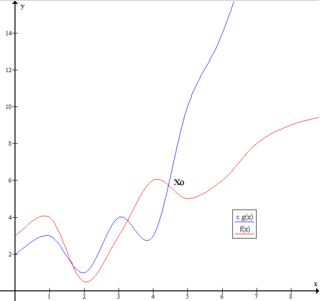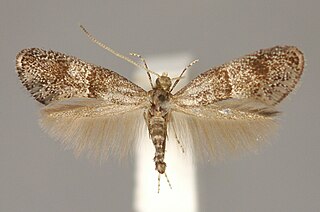
Arabic is a Semitic language that first emerged in the 1st to 4th centuries CE. It is named after the Arabs, a term initially used to describe people living in the Arabian Peninsula, as perceived by ancient Greek geographers. The International Organization for Standardization assigns language codes to 33 varieties of Arabic, including its standard form, Modern Standard Arabic (MSA), also referred to as Literary Arabic, which is modernized Classical Arabic. Native speakers of Arabic generally do not distinguish between MSA and Classical Arabic and refer to both as العربية الفصحى al-ʻarabīyah al-fuṣḥā, lit. 'the eloquent Arabic'. This variety is the lingua franca of the Arab world and the liturgical language of Islam.

In mathematics, convolution is a mathematical operation on two functions that produces a third function that expresses how the shape of one is modified by the other. The term convolution refers to both the result function and to the process of computing it. It is defined as the integral of the product of the two functions after one is reflected about the y-axis and shifted. The choice of which function is reflected and shifted before the integral does not change the integral result. The integral is evaluated for all values of shift, producing the convolution function.

G, or g, is the seventh letter of the ISO basic Latin alphabet. Its name in English is gee, plural gees.

Big O notation is a mathematical notation that describes the limiting behavior of a function when the argument tends towards a particular value or infinity. Big O is a member of a family of notations invented by Paul Bachmann, Edmund Landau, and others, collectively called Bachmann–Landau notation or asymptotic notation. The letter O was chosen by Bachmann to stand for Ordnung, meaning the order of approximation.

A Fourier transform (FT) is a mathematical transform that decomposes functions depending on space or time into functions depending on spatial frequency or temporal frequency. That process is also called analysis. An example application would be decomposing the waveform of a musical chord into terms of the intensity of its constituent pitches. The term Fourier transform refers to both the frequency domain representation and the mathematical operation that associates the frequency domain representation to a function of space or time.

Christopher George Latore Wallace, better known by his stage names the Notorious B.I.G., Biggie Smalls, or simply Biggie, was an American rapper and songwriter. Rooted in East Coast hip hop and particularly gangsta rap, he is widely considered one of the greatest rappers of all time. Wallace became known for his distinctive laid-back lyrical delivery, offsetting the lyrics' often grim content. His music was often semi-autobiographical, telling of hardship and criminality, but also of debauchery and celebration.

In mathematics, a function from a set X to a set Y assigns to each element of X exactly one element of Y. The set X is called the domain of the function and the set Y is called the codomain of the function.

The Mikoyan MiG-29 is a twin-engine fighter aircraft designed in the Soviet Union. Developed by the Mikoyan design bureau as an air superiority fighter during the 1970s, the MiG-29, along with the larger Sukhoi Su-27, was developed to counter new U.S. fighters such as the McDonnell Douglas F-15 Eagle and the General Dynamics F-16 Fighting Falcon. The MiG-29 entered service with the Soviet Air Forces in 1982.

3G is the third generation of wireless mobile telecommunications technology. It is the upgrade over 2G, 2.5G, GPRS and 2.75G EDGE networks, offering faster data transfer, and better voice quality. This network was superseded by 4G, and later on by 5G. This network is based on a set of standards used for mobile devices and mobile telecommunications use services and networks that comply with the International Mobile Telecommunications-2000 (IMT-2000) specifications by the International Telecommunication Union. 3G finds application in wireless voice telephony, mobile Internet access, fixed wireless Internet access, video calls and mobile TV.

The Group of Seven (G7) is an inter-governmental political forum consisting of Canada, France, Germany, Italy, Japan, the United Kingdom and the United States. In addition, the European Union is a 'non-enumerated member'. Its members are the world's largest IMF advanced economies and liberal democracies; the group is officially organized around shared values of pluralism and representative government. As of 2020, the collective group accounts for over 50 percent of global net wealth, 32 to 46 percent of global gross domestic product, and approximately 770 million people or 10 percent of the world's population. Members are great powers in global affairs and maintain mutually close political, economic, social, legal, environmental, military, religious, cultural, and diplomatic relations. From 2022, Germany has taken over the rotating presidency of the G7, following the presidency of the United Kingdom.

Douglasiidae is a small Lepidopteran family including around 28 species of micromoth whose adults are collectively called Douglas moths. The largest genus in the family is Tinagma. They are primarily found in the Palearctic and Nearctic realms. The adults have a 6 to 15 mm wingspan, with a reduced hindwing venation and long fringes. The larvae are leaf miners or borers, primarily in stems and petioles, belonging to Boraginaceae, Labiatae, and Rosaceae.

The iPhone is a line of smartphones designed and marketed by Apple Inc. These devices use Apple's iOS mobile operating system. The first-generation iPhone was announced by then-Apple CEO Steve Jobs on January 9, 2007. Since then, Apple has annually released new iPhone models and iOS updates. As of November 1, 2018, more than 2.2 billion iPhones had been sold.

In telecommunications, 5G is the fifth-generation technology standard for broadband cellular networks, which cellular phone companies began deploying worldwide in 2019, and is the planned successor to the 4G networks which provide connectivity to most current cellphones. 5G networks are predicted to have more than 1.7 billion subscribers and account for 25% of the worldwide mobile technology market by 2025, according to the GSM Association and Statista.
Eudonia paghmanella is a moth in the family Crambidae. It was described by Patrice J.A. Leraut in 1985. It is found in Afghanistan.

Klimeschia is a genus of moths in the family Douglasiidae. It is found in the Palearctic realm
Klimeschia afghanica is a moth in the family Douglasiidae. It was described by Reinhard Gaedike in 1974. It is found in Afghanistan, Iran and Tuva, Russia.
Klimeschia lutumella is a moth in the Douglasiidae family. It was described by Hans Georg Amsel in 1938. It is found in Israel.
Klimeschia thymetella is a moth in the Douglasiidae family. It was described by Staudinger in 1859. It is found in Portugal and Spain.

Klimeschia transversella is a moth in the family Douglasiidae. It was described by Zeller in 1839. It is found in Spain, Portugal, Italy, France, Belgium, Germany, Poland, Denmark, Austria, the Czech Republic, Slovakia, Croatia, Bosnia and Herzegovina, Hungary, Romania, North Macedonia, Greece, Finland, Sweden, Belarus, the Baltic region and Russia.
Klimeschia vibratoriella is a moth in the family Douglasiidae. It was described by Josef Johann Mann in 1862. It is found in Turkey.













